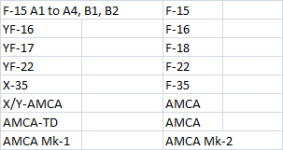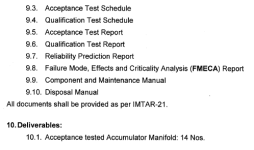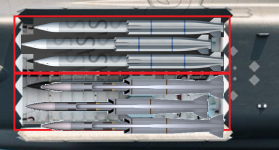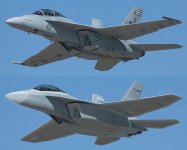I am willing to believe that the airframe will grow somewhat when the DRDO-foreign OEM 110 kN engine become available. Basically AMCA Mk-1 will be smaller/lighter than the Mk-2. This is especially true if they are serious about the AMCA being a 5.5 gen.
IDK how redesigned AMCA can be smaller & lighter further. I don't think it is possible bcoz 5.5gen means overlap with 6gen, so some more equipment, weapons, fuel would be needed. Then to balance TWR, better engine, ideally a VCE would be required which would again slightly increase weight. So our JV can make smaller VCE of 110-130KN & other strong VCE of 200-250KN for other future projects.
But for now, i showed what the current airframe is capable of, looking at YF-22 Vs F-22 & X-35 Vs F-35. The X-35 didn't even have IWB.


But today the F-35 is getting 4 to 6 AAMs upgrade + new custom weapons for it & F-22. The J-31/35'll also get it.
Similarly the AMCA prototype, you can call it X-AMCA or Y-AMCA or AMCA-TD or AMCA Mk1, etc,

can be like it has been projected, and the inducted jet would be a pumped up version, AMCA Mk2 or simply the AMCA.


AMCA program started in 2010, the CCS approval has been very late, so the protoype couldn't fly even in 15 years so far.
Bcoz IWB is old concept at least since F-102 Delta-Dagger in 1950s, so in the worst case, 6+2 AAMs config should be implemented. If not 10+4 then 8+4 or 8+2 should definitely get implemented in 1st IOC batch.
With today's materials, technologies, there should not be any problems with 70+ year old IWB concept. Inducting current AMCA model with 4 AAMs after 10 years in 2035, that's 45 years after revealling YF-22/23, would be like inducting a refurbished X/Y jet museum piece. 



Also, we've discussed this before - Our UCAV progress is pathetic. Even USA is yet to show group flying as it needs collision avoidance safety with proximity sensors. So, relying on UCAVs for missile shots is not good. The UCAVs themselves should be survivable, not target practice objects.
 GoI/MoD/IAF said this year is going to be of reforms. So they should get whatever funding, tools, facilities, people are needed.
GoI/MoD/IAF said this year is going to be of reforms. So they should get whatever funding, tools, facilities, people are needed.
We have already made 4 mistakes - late LCA, late 4gen MWF, late 4gen TEDBF, late 4gen Rafale. We should not make mistakes again with AMCA otherwise more MRFA import tenders are waiting. 

So, I am quite sure that the IWB will become bigger/deeper.
I think 4.2m X 2.2m X 0.75m is big enough for a medium jet's IWB. It can have custom weapons like AGM-88G AARGM-ER, JSM/NSM with folding fins. That also i showed on 13th & 26th Jan-25.
Fitting Ramjet missiles is a challenge bcoz of their long intakes, it becomes difficult to stagger them. There is an early render by artist Kuntal Biswas of 2 Astr-3 SFDR /bay, total 4 AAMs, but pic is angled, the bay is short with big gap in between. He has also made multiple CADs of Astr-3...

www.strategicfront.org
F 35 can scare China more than Rafale. F35 can prove to be very effective against Chinese AC and ships in ocean. It can perform certain missions which Gripen can not perform. However, Gripen too have some great capability. We need atleast 2 to 3 squadron of both plane in addition to what we have...

www.strategicfront.org

I am not sure there will be side bays though, let alone side bays that can hold 2 CCMs.
What seems more likely is that the bay doors themselves can mount a couple of missiles/bombs.
IMO, SWB for CCMs is very important for 5+gen jet.
Even 1-engine Su-75 will have it.
The SWB of Su-57 comes from wing root, not side walls of fuselage/engine-nacelle.
Also, i saw 3D CAD of conceptual F/A-XX. So they inspired me to have slightly bigger SWB for 2 CCMs.

I've not thought in detail about the launching mechanism.
Structurally, the AAMs should not be mounted on door, but the door & AAM-rail-launcher could be attached to swing-out arm, otherwise the hinges & door would have lot of stress created by Moment of Inertia of AAM & rail-launcher, directly proportional to mass & radius.
It could be a combo of Su-57 & J-20 mechanism, or Su-57 & F-22, or like f-22 only but twin rails.
That would require extensive wind tunnel work for bay door opening & closing, missile ejection, safe separation etc.
That's NORMAL part of engineering. It is the very daily job of engineers for which they get very good salary, perks. Repeating myself - We had IT boom in 1990s when i was in school. We're well into affordable Supercomputing, CAD, CFD tools, robotics, other automation. Our ISRO labs are stae of the art, if DoD can't catch up then it is combined fault of them & GoI/MoD.

1 day the automobile industry will leave them behind.

 NOTE -
NOTE - For people out of a professional domain, some big tasks appear way too difficult & monumental. I can't do a surgery


, nor can i drive a bus/truck in mountains



.


Anyhow, can you calculate the dry & wet TWR for the AMCA Mk-2? Assume the same loadout that you have proposed except with Astra Mk-3, assume each Mk-3 is 200 kgs. Each engine has 70 kN dry & 110 kN wet.
From this slide the AMCA Mk-2 will super cruise at M1.3 at 12 km with just 36 kN thrust from each engine. The MTOW by my rough calculations come out to be around 28-32 tons.
That's so simple.
empty weight = 12 tons
internal fuel = 6.5 tons
We can have max 6 Astr-3 SFDR, that's 6x200Kg = 1,200 Kg
4 CCMs = 4x88 = 352 Kg.
So STOW = 12+6.5+1.2+0.352 = 20.052 tons.
Wet TWR = 2x110/9.8 / 20.052 = 1.12
Comparing with F-22's - 2x156/9.8 / (19.7+8.2+1.1) = 1.1
MTOW, depending upon thrust & lift, can be considered roughly 2x +/- of empty weight, so 24+/- tons for AMCA, 25tons curretly quoted.
As per some studied TWR range, too much thrust is considered waste of payload potential. And utilysing airframe payload potential but weak engine also not good.
Supercruising depends on not just TWR but airframe design also. I explained it in past on 26th July 2024
All military grade software is tweaked accordingly, so intel/windows all are fine!

www.strategicfront.org


































 can be like it has been projected, and the inducted jet would be a pumped up version, AMCA Mk2 or simply the AMCA.
can be like it has been projected, and the inducted jet would be a pumped up version, AMCA Mk2 or simply the AMCA.






 , nor can i drive a bus/truck in mountains
, nor can i drive a bus/truck in mountains

 .
. 








 or helped by them at AREA-51.
or helped by them at AREA-51. 


